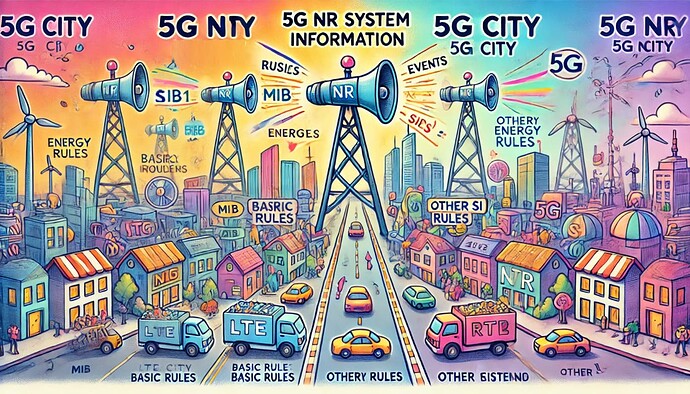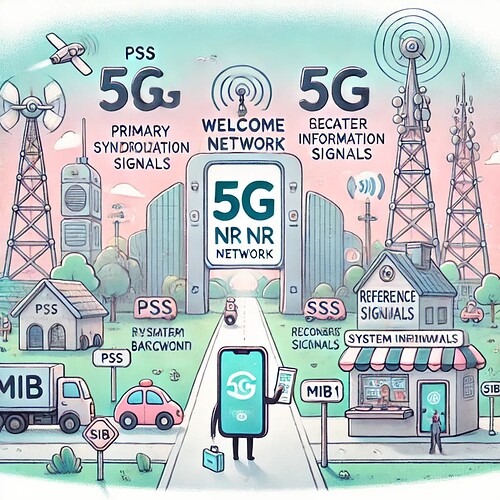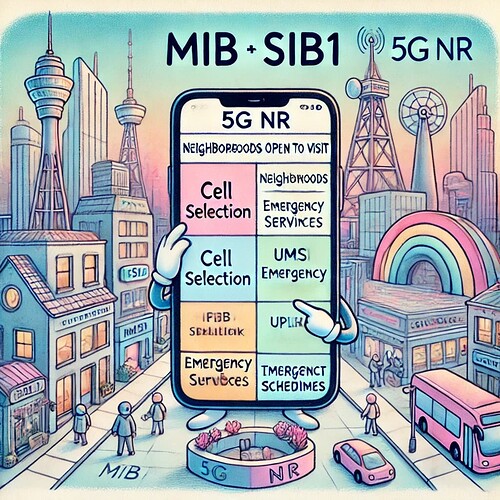This topic presents in a very simplified way all the main concepts that should be understood by those who know 5G NR.
5G NR System Information
5G NR System Information is a set of essential messages broadcast by the network to help devices connect and communicate effectively. These messages include critical details such as network configuration, cell access rules, and mobility settings. While components like the Master Information Block (MIB) and System Information Blocks (SIBs) were carried over from LTE, 5G enhances them for faster and more efficient communication. Unlike LTE, where system information like MIB, SIB1, and SIB2 is broadcast periodically across the entire cell - even when no devices are present - causing energy waste and unnecessary signaling overhead, 5G NR uses a smarter approach. It divides system information into two categories: Minimum SI and Other SI. Minimum SI, which includes MIB and SIB1, provides the basic information needed for devices to access the network. Other SI offers additional details but is only transmitted when explicitly requested by devices. This on-demand approach reduces energy consumption and signaling overhead, making 5G NR more efficient and better suited to modern network needs, such as higher speeds and lower latency. [In a Nutshell: 5G NR builds on LTE with smarter, more efficient system information handling that saves energy and reduces overhead.]
![]() In LTE City, there’s a big speaker system that constantly announces all the city’s information - like the rules, events, and maps - even if no one is around to listen. This wastes energy and keeps running all the time. But in 5G NR City, the speaker system is smarter. It only announces the most important information, like the city’s basic rules (MIB and SIB1), so newcomers know how to get started. If someone needs extra details, like where the best restaurants or parks are, they can press a button and request it, and the speaker will share it only when needed. This way, 5G NR City saves energy and works more efficiently, helping everyone get what they need faster without unnecessary noise. [In a Nutshell: 5G NR City uses a smarter speaker system to share only necessary information, saving energy and improving efficiency.]
In LTE City, there’s a big speaker system that constantly announces all the city’s information - like the rules, events, and maps - even if no one is around to listen. This wastes energy and keeps running all the time. But in 5G NR City, the speaker system is smarter. It only announces the most important information, like the city’s basic rules (MIB and SIB1), so newcomers know how to get started. If someone needs extra details, like where the best restaurants or parks are, they can press a button and request it, and the speaker will share it only when needed. This way, 5G NR City saves energy and works more efficiently, helping everyone get what they need faster without unnecessary noise. [In a Nutshell: 5G NR City uses a smarter speaker system to share only necessary information, saving energy and improving efficiency.]
Skip to: Roadmap to 5G NR
- MIB (Master Information Block)
- SIB1 (System Information Block 1)
- SIB2 (System Information Block 2)
- SIB3 (System Information Block 3)
- SIB4 (System Information Block 4)
- SIB5 (System Information Block 5)
- SIB6 (System Information Block 6)
- SIB7 (System Information Block 7)
- SIB8 (System Information Block 8)
- SIB9 (System Information Block 9)
- SIB10 (System Information Block 10)
- SIB11 (System Information Block 11)
- SIB12 (System Information Block 12)
- SIB13 (System Information Block 13)
- SIB14 (System Information Block 14)
- SIB15 (System Information Block 15)
- SIB16 (System Information Block 16)
- SIB17 (System Information Block 17)
- SIB18 (System Information Block 18)
- SIB19 (System Information Block 19)
- SIB20 (System Information Block 20)
- SIB21 (System Information Block 21)
MIB (Master Information Block)
In 5G, when a device (UE) powers on or moves between network areas, it needs to connect to a nearby cell by performing a process called “cell search.” During this process, the device syncs its time and frequency with the cell and identifies the cell’s unique Physical Cell ID (PCI). To achieve this, the device uses special signals: the Primary Synchronization Signal (PSS) and the Secondary Synchronization Signal (SSS), which help determine the PCI. These signals, along with the Physical Broadcast Channel (PBCH), form the Synchronization Signal Block (SSB). The PBCH carries critical information, including the Master Information Block (MIB), which provides initial details about the cell, such as system bandwidth and reference signals. The MIB also includes the System Frame Number (SFN) for timing synchronization, details for locating the next important block (SIB1), and flags indicating whether the cell is accessible or allows intra-frequency reselection. Additionally, it specifies the Subcarrier Spacing (SCS), a key feature unique to 5G that supports flexible frequency configurations, unlike LTE’s fixed subcarrier spacing of 15 kHz. The SIB1 PDCCH resource in 5G helps the device locate further configuration data, similar to LTE but adapted to the 5G NR frame structure. By decoding the PBCH and MIB, the device can access further system information on channels like the Physical Downlink Shared Channel (PDSCH), allowing it to connect and communicate with the 5G network efficiently. [In a Nutshell: The UE uses signals like PSS, SSS, PBCH, and MIB to identify and sync with a 5G cell, ensuring timing, access setup, and flexible 5G-specific features like subcarrier spacing.]
![]() Imagine 5G as a futuristic city where everything runs super smoothly. The cell towers are like traffic control towers managing the flow of cars (data) so there are no jams. When you arrive, the PSS and SSS signals act like big welcome signs, helping you figure out where you are and how to enter the city. Once inside, you visit the MIB, the city’s information booth, which gives you a quick guide with essential details, like where to go next and the city’s rules. With this info, you’re ready to navigate the city efficiently and enjoy all its smart features! [In a Nutshell: In the 5G city, the signals guide you to the info booth (MIB), where you get a map and instructions to enjoy the city seamlessly.]
Imagine 5G as a futuristic city where everything runs super smoothly. The cell towers are like traffic control towers managing the flow of cars (data) so there are no jams. When you arrive, the PSS and SSS signals act like big welcome signs, helping you figure out where you are and how to enter the city. Once inside, you visit the MIB, the city’s information booth, which gives you a quick guide with essential details, like where to go next and the city’s rules. With this info, you’re ready to navigate the city efficiently and enjoy all its smart features! [In a Nutshell: In the 5G city, the signals guide you to the info booth (MIB), where you get a map and instructions to enjoy the city seamlessly.]
- Search Forum
 5G NR MIB (Master Information Block)
5G NR MIB (Master Information Block) 
SIB1 (System Information Block 1)
System Information (SI) in 5G NR includes two main parts: the Master Information Block (MIB) and System Information Blocks (SIBs). These are divided into Minimum SI and Other SI. Minimum SI, which consists of MIB and SIB1, provides the basic information needed for a device (UE) to connect to a cell and access additional system details. To read SIB1, the device first decodes the MIB for initial setup. SIB1 contains critical details like network identification (e.g., PLMN list, Cell ID, tracking area code), support for emergency services, and instructions for handling connection failures. It also provides scheduling for other information blocks, configurations for communication (like uplink/downlink and paging), and advanced features such as Supplementary Uplink (SUL) and Time Division Duplexing (TDD). In 5G, SIB1 improves on LTE by supporting emergency IMS calls, offering more detailed access controls, and enabling advanced mobility and service configurations, showcasing the flexibility of 5G for diverse needs. [In a Nutshell: The MIB gives devices basic startup info, while SIB1 adds critical details like network ID, emergency support, and advanced configurations to enable efficient connectivity in 5G.]
![]() Imagine 5G as a big, futuristic city, and you’re a visitor exploring it. When you arrive, you first stop at the MIB, which is like the city’s welcome desk. It gives you basic info, like the city’s name and where to find important areas. Then, you head to the SIB1, a giant notice board at the town square. This board has all the details you need to navigate the city: which neighborhoods are open to visit (cell selection), emergency phone numbers (IMS emergency services), and how to catch the right buses (uplink/downlink configurations). It even tells you when the trains (data signals) arrive and which streets are one-way (TDD configurations). With SIB1’s help, you can move around the city easily and enjoy all the cool features it offers! [In a Nutshell: The MIB acts as the welcome desk, and SIB1 is the detailed guide helping you explore and enjoy the 5G city seamlessly.]
Imagine 5G as a big, futuristic city, and you’re a visitor exploring it. When you arrive, you first stop at the MIB, which is like the city’s welcome desk. It gives you basic info, like the city’s name and where to find important areas. Then, you head to the SIB1, a giant notice board at the town square. This board has all the details you need to navigate the city: which neighborhoods are open to visit (cell selection), emergency phone numbers (IMS emergency services), and how to catch the right buses (uplink/downlink configurations). It even tells you when the trains (data signals) arrive and which streets are one-way (TDD configurations). With SIB1’s help, you can move around the city easily and enjoy all the cool features it offers! [In a Nutshell: The MIB acts as the welcome desk, and SIB1 is the detailed guide helping you explore and enjoy the 5G city seamlessly.]
- Search Forum
 5G NR SIB1 (System Information Block 1)
5G NR SIB1 (System Information Block 1) 
SIB2 (System Information Block 2)
-
Shares information for switching between cells in the same area for better connectivity (serving cell reselection).
- Contains Cell re-selection information, mainly related to the serving cell.
-
Search Forum
 5G NR SIB2 (System Information Block 2)
5G NR SIB2 (System Information Block 2) 
SIB3 (System Information Block 3)
-
Explains how to switch between nearby cells that are using the same frequency (intra-frequency cell reselection parameters).
- Contains Information about the serving frequency and intra-frequency neighbouring cells relevant for cell re-selection (including cell re-selection parameters common for a frequency as well as cell specific re-selection parameters).
-
Search Forum
 5G NR SIB3 (System Information Block 3)
5G NR SIB3 (System Information Block 3) 
SIB4 (System Information Block 4)
-
Guides your device on switching between cells that use different frequencies for a smooth connection (inter-frequency cell reselection).
- Contains Information about other NR frequencies and inter-frequency neighbouring cells relevant for cell re-selection (including cell re-selection parameters common for a frequency as well as cell specific re-selection parameters).
-
Search Forum
 5G NR SIB4 (System Information Block 4)
5G NR SIB4 (System Information Block 4) 
SIB5 (System Information Block 5)
-
Helps your device work with older LTE networks by giving information about nearby LTE cells (E-UTRA frequency reselection).
- Contains Information about E-UTRA frequencies and E-UTRA neighbouring cells relevant for cell re-selection (including cell re-selection parameters common for a frequency as well as cell specific re-selection parameters).
-
Search Forum
 5G NR SIB5 (System Information Block 5)
5G NR SIB5 (System Information Block 5) 
SIB6 (System Information Block 6)
Broadcasts urgent messages in case of emergencies (primary notification).
-
Contains ETWS (Earthquake and Tsunami Warning System) primary notification.
-
Search Forum
 5G NR SIB6 (System Information Block 6)
5G NR SIB6 (System Information Block 6) 
SIB7 (System Information Block 7)
-
Sends additional details about emergency situations (secondary notification).
- Contains ETWS (Earthquake and Tsunami Warning System) secondary notification.
-
Search Forum
 5G NR SIB7 (System Information Block 7)
5G NR SIB7 (System Information Block 7) 
SIB8 (System Information Block 8)
-
Alerts devices about critical warnings, such as natural disasters.
- Contains CMAS (Commercial Mobile Alert System) warning notification.
-
Search Forum
 5G NR SIB8 (System Information Block 8)
5G NR SIB8 (System Information Block 8) 
SIB9 (System Information Block 9)
-
Provides timing information to help your device synchronize with global time standards like GPS and UTC. This ensures network-wide timing consistency for time-sensitive applications.
- Contains Information related to GPS time and Coordinated Universal Time (UTC).
-
Search Forum
 5G NR SIB9 (System Information Block 9)
5G NR SIB9 (System Information Block 9) 
SIB10 (System Information Block 10)
-
Lists readable network names for private or special-purpose networks, specifically for Non-Public Networks (NPNs).
- Contains Human-Readable Network Names (HRNNs) of the NPNs listed in SIB1.
-
Search Forum
 5G NR SIB10 (System Information Block 10)
5G NR SIB10 (System Information Block 10) 
SIB11 (System Information Block 11)
-
Gives instructions for your device to measure and optimize its connection while idle or inactive (idle/inactive state measurements).
- Contains Information related to idle/inactive measurements.
-
Search Forum
 5G NR SIB11 (System Information Block 11)
5G NR SIB11 (System Information Block 11) 
SIB12 (System Information Block 12)
-
Configures your device for direct communication with nearby devices (e.g., for vehicle-to-vehicle communication - V2X).
- Contains NR sidelink communication configuration.
-
Search Forum
 5G NR SIB12 (System Information Block 12)
5G NR SIB12 (System Information Block 12) 
SIB13 (System Information Block 13)
-
Provides additional settings for advanced vehicle-to-vehicle communication.
- Contains Configurations of V2X sidelink communication defined in TS 36.331.
-
Search Forum
 5G NR SIB13 (System Information Block 13)
5G NR SIB13 (System Information Block 13) 
SIB14 (System Information Block 14)
-
Adds complementary settings for more complex vehicle-to-vehicle communication (configurations complementing SIB13).
- Contains Configurations of V2X sidelink communication defined in TS 36.331, which can be used jointly with that included in SIB13.
-
Search Forum
 5G NR SIB14 (System Information Block 14)
5G NR SIB14 (System Information Block 14) 
SIB15 (System Information Block 15)
-
Shares information for emergency network use during disasters (disaster roaming configuration).
- Contains Configurations of disaster roaming information.
-
Search Forum
 5G NR SIB15 (System Information Block 15)
5G NR SIB15 (System Information Block 15) 
SIB16 (System Information Block 16)
-
Helps your device choose the right part of the network for specialized services like slicing. This is useful for network slicing configurations tied to specific service-level agreements (SLAs).
- Contains Configurations of slice specific cell reselection information.
-
Search Forum
 5G NR SIB16 (System Information Block 16)
5G NR SIB16 (System Information Block 16) 
SIB17 (System Information Block 17)
-
Prepares your device for efficient connections (TRS) when it’s not actively being used. Tracking Reference Signal (TRS) configurations enable better synchronization and mobility handling for idle/inactive UEs.
- Contains Configurations of TRS (Tracking Reference Signal) resources for idle/inactive UEs.
-
Search Forum
 5G NR SIB17 (System Information Block 17)
5G NR SIB17 (System Information Block 17) 
SIB18 (System Information Block 18)
-
Supports selecting and connecting to private or enterprise networks using credentials. Standalone Non-Public Networks (SNPNs) rely on onboarding processes for enterprise-grade security and access control.
- Contains Group IDs for Network selection (GINs) to support access using credentials from a Credentials Holder or to enable UE onboarding. SIB18 may only be present if there is at least one SNPN (Standalone Non-Public Network) that supports either access using credentials from a Credentials Holder or UE onboarding.
-
Search Forum
 5G NR SIB18 (System Information Block 18)
5G NR SIB18 (System Information Block 18) 
SIB19 (System Information Block 19)
-
Provides help for satellite-based connectivity and navigation.
- Contains NTN-specific parameters for serving cell and/or neighbour cells satellite assistance information.
-
Search Forum
 5G NR SIB19 (System Information Block 19)
5G NR SIB19 (System Information Block 19) 
SIB20 (System Information Block 20)
-
Explains how to receive broadcast messages like news or alerts efficiently through Multicast Communication Channel (MCCH) configurations.
- Contains Information required to acquire the MCCH configuration for MBS broadcast.
-
Search Forum
 5G NR SIB20 (System Information Block 20)
5G NR SIB20 (System Information Block 20) 
SIB21 (System Information Block 21)
-
Links specific services like video streaming to the correct frequencies.
- Contains Mapping between frequency and MBS services.
-
Search Forum
 5G NR SIB21 (System Information Block 21)
5G NR SIB21 (System Information Block 21) 
That’s it. ![]()
-
Continue reading: Roadmap to 5G NR - Uplink Signals and Channels
-
Or back to: Roadmap to 5G NR


